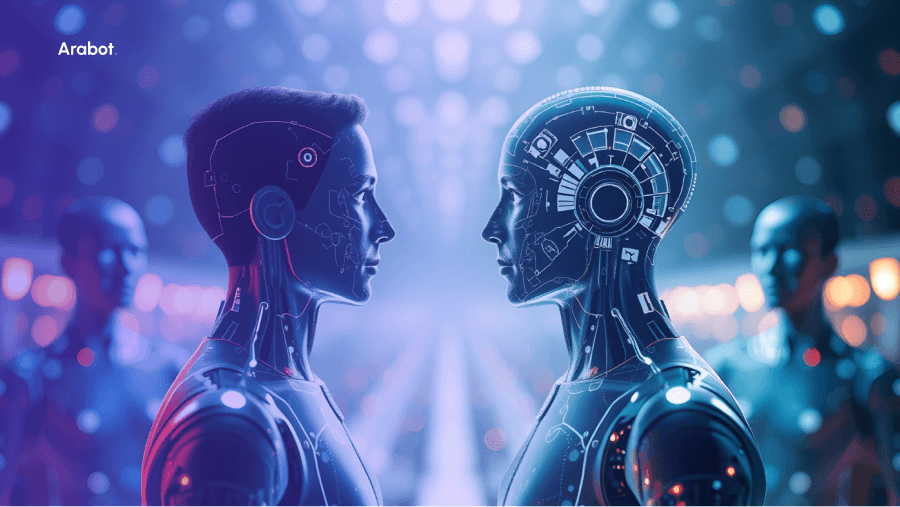Education
AI Chatbots vs Generative AI: What You Need to Know

Introduction
Artificial intelligence (AI) is everywhere these days. It's in your phone's suggestions, your email filter, and more. Basically, AI lets machines act intelligently, doing things that usually require human smarts.
AI is a big field with many areas. Two exciting ones are conversational AI and generative AI. Conversational AI lets machines chat with us in a natural way, understanding our language and responding. Generative AI creates entirely new things, like text, images, or even music.
This blog post will explore conversational and generative AI. We'll see what they do, how they work, and where they're used. We'll also look at what the future holds for these powerful AI tools. Let's see how AI is changing the way we communicate and create.
What is Conversational AI?
Ever talked to your phone and gotten a response? That's conversational AI in action. It allows machines to understand what you say and respond in a natural way. This is powered by two key technologies:
- Natural Language Processing (NLP): This helps machines understand the meaning behind words, not just the words themselves.
- Machine Learning: This lets machines learn from vast amounts of data, improving their ability to hold conversations.
Examples of conversational AI include familiar tools like Siri, Alexa, and chatbots you might encounter on websites. While these tools are helpful, they aren't perfect. Accuracy can be around 15-20%, so there's room for improvement.
Conversational AI is trained on massive datasets of conversations. By analyzing these conversations, machines learn patterns and how to respond appropriately.
What is Generative AI?
Imagine a machine that can create entirely new things, like paintings, songs, or even articles! That's generative AI in action. It uses special techniques like:
- Generative Adversarial Networks (GANs): These pit two AI models against each other, one creating new data and the other trying to tell if it's real. This competition helps both models improve.
- Autoencoders: These machines learn by trying to recreate their input data. In the process, they discover hidden patterns and can use them to generate new content.
Some well-known examples of generative AI include GPT-3 for writing text, DALL-E for creating images, and ChatGPT for chat conversations. These models are trained on massive datasets from the internet, allowing them to generate incredibly creative content.
Generative AI works by analyzing patterns in this data. By understanding these patterns, it can create entirely new and original content that wasn't explicitly programmed.
Key Differences: Conversation vs. Creation
Conversational AI and generative AI might seem like interchangeable terms at first glance. Both utilize advanced technologies and vast datasets, but they have distinct goals and functionalities. Let's go into the key differences that set them apart:
- Purpose: Conversational AI prioritizes facilitating communication between humans and machines. It strives to understand our natural language (written or spoken) and respond in a way that simulates human conversation. Imagine interacting with a virtual assistant who can answer your questions, schedule appointments, or place orders – that's the power of conversational AI.
In contrast, generative AI focuses on the creation of entirely new content. It analyzes vast amounts of data, identifies underlying patterns, and uses this knowledge to generate fresh and original outputs. This could be anything from composing a poem or writing a news article to creating a realistic image or a catchy piece of music. Generative AI pushes the boundaries of creative expression and assists in content development across various fields.
- Capabilities: Conversational AI excels in understanding and responding to human language. It employs Natural Language Processing (NLP) to decipher the meaning behind our words, taking into account context, grammar, and sentiment. This allows conversational AI to hold meaningful conversations, answer questions accurately, and even generate human-like dialogue.
On the other hand, generative AI boasts a wider range of capabilities in terms of content generation. It can produce various creative outputs, from text formats like poems, code, scripts, or musical pieces to visual formats like images, videos, and even 3D models. This versatility makes generative AI a valuable tool in various creative industries like design, marketing, and entertainment.
- Input/Output: Conversational AI primarily deals with language as both input and output. Users communicate with conversational AI systems through spoken or written language, and the system responds in the same way. This back-and-forth exchange allows for natural and interactive communication.
Generative AI, however, has a more flexible input/output structure. It can take in a wider variety of data formats as input, such as text, code, or images. By analyzing this data, it identifies patterns and uses them to generate entirely new content formats as output. This could be text in a different style, a completely new image, or even a musical composition based on a specific genre.
- Training Data: Both conversational AI and generative AI rely heavily on training data. Conversational AI is trained on massive datasets of conversations. These datasets include real-world interactions between people, allowing the AI to learn the nuances of human language, humor, and sarcasm. The more data a conversational AI system is exposed to, the better it becomes at understanding and responding to complex queries and requests.
Generative AI, however, utilizes a broader range of training data. It can be trained on text data like books, articles, code repositories, or even social media conversations. Additionally, it can be trained on visual data sets like image collections or video archives. This vast amount of training data allows generative AI to identify complex patterns and create highly realistic or creative outputs.
- Goals: The ultimate goal of conversational AI is to achieve realistic and informative responses. It strives to understand the user's intent, provide accurate information, and engage in a natural conversation that mimics human interaction. This focus on realism is crucial for building trust and ensuring a positive user experience.
Generative AI, on the other hand, prioritizes originality and creativity in its content generation. While some generative AI models might aim for realistic outputs, the core focus is on producing something new and unique. This could be a novel idea, a fresh perspective, or simply a piece of content that is engaging and thought-provoking.
Conversational AI empowers us to interact with machines in a natural way, while generative AI broadens the horizons of creative expression and content development.
Conversational AI Use Cases
Conversational AI has transcended the realm of science fiction and become a reality with a wide range of practical applications. Let's explore some of the most impactful ways conversational AI is transforming how we interact with technology and services:
- Customer Service: Conversational AI is revolutionizing customer service by offering 24/7 availability and efficient resolution of inquiries. Chatbots powered by conversational AI can answer frequently asked questions, troubleshoot basic issues, and even schedule appointments, freeing up human agents for more complex tasks. This leads to improved customer satisfaction and reduced wait times.
- Language Translation: Conversational AI is breaking down language barriers by providing real-time translation services. Translation tools powered by AI can translate spoken conversations or written text with increasing accuracy, enabling seamless communication across cultures. This fosters global collaboration and opens doors to new markets.
- Education: Conversational AI is making education more personalized and engaging. AI-powered tutors can provide students with individualized learning experiences, answer questions on-demand, and offer feedback on assignments. This allows students to learn at their own pace and receive targeted support for their needs.
- Personal Assistants: Conversational AI is simplifying our daily lives through virtual assistants like Siri, Alexa, and Google Assistant. These AI assistants can manage our schedules, set reminders, control smart home devices, and even answer our questions in an informative way. This enhances productivity and streamlines daily tasks.
As the technology matures, we can expect even more innovative ways to leverage conversational AI for improved communication and streamlined experiences across various industries.
Generative AI Use Cases: Creativity and Innovation
Generative AI isn't just about creating quirky images or mimicking human writing styles. It's rapidly becoming a powerful tool that fuels creativity and innovation across various industries. Let's delve into some of the exciting ways generative AI is transforming how we approach content creation and problem-solving:
- Art and Design: Generative AI is inspiring a new wave of artistic expression. AI-powered tools can create stunning visuals, generate unique design concepts, and even compose music with captivating melodies and rhythms. This empowers artists and designers to explore new creative possibilities and push the boundaries of their craft. Imagine an AI tool that can generate a variety of color palettes or suggest unique design layouts based on your initial idea.
- Marketing and Advertising: Generative AI is transforming marketing strategies by creating personalized and engaging content. AI can generate targeted ad copy, personalize website content for individual users, or even develop captivating product descriptions. This allows businesses to reach their target audience more effectively and create a more impactful marketing experience.
- Content Creation: Generative AI is streamlining content creation workflows for various industries. AI-powered tools can generate different content formats, from writing blog posts and social media captions to creating video scripts and product descriptions. This frees up human content creators to focus on higher-level tasks like strategy and editing, leading to increased efficiency and content production speed.
- Scientific Discovery: Generative AI is assisting researchers in scientific fields by accelerating discovery processes. AI can be used to generate new hypotheses, analyze vast datasets for hidden patterns, and even propose potential solutions to complex problems. This can significantly reduce research time and pave the way for groundbreaking discoveries in fields like medicine, materials science, and engineering.
The Future
The world of conversational and generative AI is constantly evolving, and the future holds exciting possibilities for both. Here's a glimpse into what we might expect:
- Conversational AI: We can anticipate further advancements in natural language processing (NLP), enabling conversational AI to understand human language with even greater nuance and context. This will lead to more natural and engaging conversations with machines, blurring the lines between human and machine interaction. Imagine virtual assistants that can not only answer your questions but also understand your emotions and respond accordingly.
- Generative AI: The future of generative AI lies in its ability to produce an even wider variety of content formats. We might see AI generating not just text and images but also realistic 3D models, interactive experiences, and even personalized educational materials. This opens doors for entirely new avenues of creative expression and content delivery.
- Integration and Expansion: As both conversational and generative AI technologies mature, we can expect a greater convergence between them. Imagine virtual assistants that can not only answer your questions but also generate creative content based on your needs. Additionally, the applications of these AI subfields will likely expand to encompass new industries and domains, further transforming the way we live, work, and interact with the world around us.
The future of AI is undoubtedly collaborative. By combining the strengths of conversational AI and generative AI, we can unlock a future where machines not only understand us but also assist us in creative endeavors and problem-solving in innovative ways.
Conclusion
Both AI subfields rely on different approaches but share a common goal: to make our lives easier and more efficient. Conversational AI empowers us to interact with machines in a natural way, while generative AI broadens the horizons of content creation and problem-solving.
As these technologies continue to evolve, we can expect even more transformative applications across various industries. From revolutionizing customer service to inspiring artistic expression and accelerating scientific discovery, conversational and generative AI hold immense potential for shaping the future.
arabot can tailor the perfect AI solution to fulfill your business needs. Find out how now!
© 2025 copyright Arabot. All rights reserved.
 Insurance
Insurance Healthcare
Healthcare Automative
Automative Hospitality
Hospitality Banking
Banking Government
Government Telecommunication
Telecommunication Education
Education Human Resources
Human Resources
